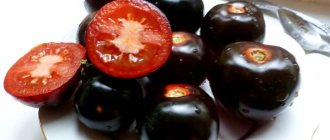The watermelon variety Kholodok is a real highlight of domestic gardening. It can be grown not only for yourself, but also for sale. It gained popularity due to its long shelf life and distinct taste.
Watermelon variety "Chill"
watermelon “Chill” is an achievement of Russian selection
“Kholodok” variety is very popular due to its delicate, juicy, sweet taste and long shelf life
History of selection and region of growth
For the first time, the melon crop Kholodok appeared in the deserts of Africa. The Egyptians were able to develop this variety many years ago. The variety came to Russia in the 8th century.
At first, Kholodok was small in size and had a cloying taste with a slight bitterness. However, it was cultivated (breeders crossed the original Kholodok with two more types of watermelon) and the berry acquired a sweet taste and grew significantly in size. The Volgograd region is considered the birthplace of this melon crop.
It brings good harvests in the Volga region, Southern Urals, and Astrakhan. The entire area of our homeland is an excellent area for growing crops for industrial purposes. Astrakhan is considered the capital of the watermelon business.
Pay attention to the appearance of the fetus
When the melon variety is selected, they begin to inspect each berry. The peel must be absolutely intact, without growths or punctures and with a uniform color. Those who know how to preserve watermelons until the new year advise taking only thick-skinned specimens with a small mark from lying on their side. The weight of the berry is no more than 5 kg.
The tail is of no small importance. Its dryness indicates the full ripeness of the watermelon in its natural environment. The absence of a tail eloquently indicates that the ripening process ended in a supermarket or warehouse.
It is advisable to select fruits in mid-autumn, taking into account the main external signs.
The ripeness of the product is determined by light tapping. If a dull sound is heard, it means that the berry has dense pulp and is ready for storage for future use. The fruits are transported in wooden boxes with fresh straw.
Characteristics of the variety
It differs from other representatives of its species in its unique ease of care, long shelf life and excellent taste. The plant can be grown indoors and outdoors. Chill is characterized by low calorie content and a huge amount of micronutrients. It is impossible to allocate a small area for its cultivation; it will begin to grow and branch.
One shoot can reach 5 m in length.
The foliage of the plant is green, the berries are slightly elongated, the weight of one fruit is about 4 kg. The skin is green, of medium thickness. When cut, the berry is red-grained, the pulp is tasty with a pink tint.
Coldweed survives low temperatures without problems, but it is better to grow it in warm climates with long summers. They begin to pick berries at the end of summer. Stored until the first frost.
How to test watermelon for nitrates at home
Unfortunately, it is difficult to choose a ripe watermelon without nitrates, because it is almost impossible to independently check the fruit for their content when purchasing, unless, of course, you have a special device that determines nitrates - a nitrate meter. But you can conduct a small experiment at home and understand whether the product is worth eating or not.
There are several signs indicating a high nitrate content in watermelon:
- The berry contains white or yellow veins, as well as compactions in the pulp.
- When a fruit is immersed in water, it sinks to the bottom and does not float up (a quality product should float up).
- Place a small amount of pulp in water for about 15 minutes. If the liquid turns bright pink or red, it means the berry has a high nitrate content. And if the water becomes a little cloudy or pale pink, then the berry is of high quality.
Advice! The highest concentration of nitrates in the berry is near the rind, so you should not bite the watermelon in these places.
Advantages and disadvantages of the variety
A huge list of advantages ensured that the culture spread widely throughout the post-Soviet space.
Advantages of watermelon Chill:
- sweet fruits;
- impeccable trade appearance;
- bears a large number of fruits;
- long storage period;
- excellent transportation;
- withstand different temperatures.
Disadvantages of watermelon:
- a huge area is required for its cultivation;
- additional shoots - shoots regularly form on the berries, which should be removed manually.
The video below provides an overview of the “Kholodok” variety of watermelon:
Where, when and how best to grow watermelon Chill?
Planting in open soil should be done no earlier than the end of May, otherwise the plant will not take root. The location should be sunny without drafts. If the climate in your region is harsh, then plant the seedlings in a greenhouse or greenhouse.
Not every gardener can grow a crop. The plant needs constant care. If the conditions are not right, the berries will not grow as sweet as they should be.
Seed preparation
Today, watermelon seeds can be purchased at any gardener's market or in a specialized store. However, the melon grower must be sure that the seeds he purchased are truly high-quality planting material.
One Chill seed reaches 1.5 cm - for this crop this figure is considered significant. The bone is rough to the touch.
The seeds respond well to heating; this activity needs to be carried out within a week; it is enough to expose the seeds to the sun. You can warm them up at home using special heaters. At home, bones are dried for 4 hours a day for a week.
Before planting, the seeds should be kept in a manganese solution and then washed under running water.
Sowing seeds
You can plant watermelon seeds using 2 methods: on seedlings and in the soil. Let's look at each of them:
- For seedlings. Watermelon seeds are sown in prepared pots filled with soil. Planting is carried out according to the 70x150 cm pattern. The best time for planting seeds for seedlings is April - if the seedlings are transplanted into a greenhouse, and the end of May - if they are transplanted into open soil. The seedlings are ready for transplanting after 1 month; 4 full-fledged leaves are formed on the plant.
- In open ground. Some gardeners plant seeds directly in open ground. When the plants begin to sprout, weak and diseased shoots are removed, leaving only strong specimens. This method is not entirely convenient, since not every seed can live in open ground. It is better to use the first option.
Seedling care
Watermelon seedlings will begin to grow and fully develop if three main conditions are met:
- constant watering;
- 12 hour lighting;
- application of fertilizers.
Seedlings should be watered with settled, non-cold water. During watering, moisture should not get on the leaves. If natural light is not enough, then special phytolamps should be installed.
After the third leaf appears on the plant, the crop is fed with slurry or a complex fertilizer. Before planting in the garden, seedlings are hardened off outdoors. On the first day, they are taken out for a couple of hours, then for three, four hours, etc. This procedure helps the seedlings get used to fresh air.
Thanks to hardening, Chill takes root faster in open soil.
Landing in the ground
The first step is to choose the right soil, because watermelon does not thrive in every soil. Lightweight, breathable soils are suitable. Planting can be done in 2 ways:
- Planting in a greenhouse. This method is applicable for central Russia. Plants are planted in rows, with about 80 cm left between seedlings. Watermelon Chill occupies a large area and has a powerful root system, so distance must be maintained. The width between the rows should be about 1.5 m. The lashes are tied to trellises. For branches up to 1.5 m in length, all side shoots are cut off. It is necessary to pinch shoots above 0.5 m.
- Planting in open soil. This method is suitable for any southern region. The ground must be warmed up, the plant is planted to a depth of 0.1 m. The chill develops “in the spread”: using the standard method.
Planting watermelons
In order for planted plants to quickly take root and form without problems, you need to add nitrogen-containing fertilizers to the ground half a month before planting. Depending on the location of growth, the planting pattern differs. If watermelons are grown in an open-air garden, then they are planted according to a scheme of 140x110 cm, if in a greenhouse - 70x70 cm, although the dimensions may be different. Planting can be done with seeds or seedlings. To do this, holes are made 10 cm deep. Seedlings or seeds are placed in them. The holes are filled with soil and watered.
Features of care
The plant will not be able to grow without care. Watermelon should be watered and fed regularly. Preventive treatments against pests and diseases occupy an important place.
Removing excess shoots provides the plant owner with a tasty and rich harvest. There are no more than 4 berries per bush.
In the greenhouse, it is necessary to provide the watermelon with air. The variety dies in high humidity. In closed ground, watermelons are tied up, the berries are put in nets or placed on stands.
Watering
Watering should be carried out once every 10 days. For 1 sq. m should pour out about 3 buckets of settled warm water. The amount of watering increases on sunny days and during flowering plants. In this case, water is added 2 times a week.
Additionally, moisten the soil between plantings. After adding water, the ground is cleared of grass and organic residues.
Loosening
Loosening is carried out on wet soil. When the watermelons grow, this procedure need not be carried out, because tools for working in the garden can damage the root system of the plants, as well as harm the berries themselves.
Top dressing
Watermelon Chill is fed twice in one season:
- 2 weeks after transplanting the plant into open ground. Fertilize with nitrogen. You can use simple natural remedies such as chicken manure or mullein. The ratio of fertilizer to water should be 1:12. Apply the substance at the root; do not pour the product on the leaves and shoots. Second feeding option: use ammonium nitrate. Dilute 20 g of this product in 5 liters of water. In the future, refuse nitrogen, as it helps to increase the green mass of the plant.
- During the formation of buds. Use complex fertilizers. One plant will require 5 g of potassium salt and 5 g of superphosphate. The products are applied to the ground or dissolved in water.
Trimming
Formative pruning helps get rid of excess shoots on the plant. This event also includes pinching the main vine; there should be 3 or 4 set fruits on the bush. A larger number of them leads to the appearance of small and tasteless berries.
Garter
After the seedlings have gotten a little stronger, they should be tied up. This event will significantly save time and effort for the owner of Kholodok watermelons.
Tied to a trellis at a height of 0.5 m from the ground. This is done to ensure that each plant receives sufficient light and warmth. Do not forget to cut off the side shoots of tied fruits.
Collecting seeds
There is no need to purchase Kholodok watermelon seeds if you can collect them yourself. The variety is not a hybrid species, so the seeds of the fruit are excellent for creating a harvest next year.
To collect seeds from a watermelon, you need to leave a couple of fruits on the plant; you should not remove them. The plants must be overripe. After which the fruit is cut and seeds of a dark shade are selected.
Natural selection is carried out: all the seeds are placed in water and those that sank to the bottom are suitable for growing next year. They are dried on a cloth and left in the sun. They should dry for about 1 week.
Watermelon seeds are stored in a simple cloth. Any closed containers cannot be used.
Optimal conditions for good growth
Plenty of sun, moderate watering and light soil - provide this to Chill, and the variety will respond with an excellent harvest.
Watering
Striped berries do not like excessive watering. Water the watermelons as the top layer of soil dries out. Over-watering will spoil the taste of the fruit and significantly reduce the yield. Water Chill once every 7-10 days, depending on weather conditions. During the flowering period, watering is increased and done twice a week.
Feeding and fertilizers
The first root feeding of watermelons is carried out a couple of weeks after planting the seedlings in the ground. Feed with a solution of mullein or chicken droppings at the rate of 1 part fertilizer to 15 parts water.
When the first ovary appears, feed the plants a second time, using complex fertilizer for melons and melons in strict accordance with the manufacturer’s recommendations.
Ammonium nitrate is often used to feed watermelons; this fertilizer should be used very carefully - excess can significantly worsen the taste of the fruit.
The soil
The soil for melons needs light and fertile. You can pre-sow green manure plants on it before winter. Winter wheat, rye, and peas are suitable. After the emergence of seedlings, the area is dug up.
Important: watermelons are not planted after melons and pumpkins, and they are not sown in the same place for several seasons.
You can add rotted manure to the site in the fall and dig the soil deeply. Melons do not like acidic soils, and watermelons do not grow in waterlogged areas. A sunny place protected from the wind is suitable for planting. Good predecessors for watermelons are tomatoes, legumes, and corn.
Diseases and pests
If the planting material is of high quality, then the crop will not get sick. Many reviews claim that Chill is moderately resistant to fusarium, anthracnose and powdery mildew. With proper planting, the risk of such ailments is minimal.
Many diseases appear due to fungal spores. Its spread on the plant leads to the formation of various spots on the foliage. As a result, the taste of the berries becomes worse, they rot and change their shape.
Diseases should be fought with special means, the best of which are Decis, Fundazol and Bordeaux mixture.
Watermelons grown in a greenhouse can be a target for some pests. The main enemies: spider mites and melon aphids. They drink the juice of the leaves, causing the green mass to dry out. You can fight insects using folk remedies. Infusions of potato tops, dope and chamomile are used.
To prevent aphids from attacking Chill watermelons, plants are dusted with tobacco dust and wood ash. Chemicals can only be used until flowering.
Harvest and storage
Ripe fruits are smooth, shiny, with a dry tail; when tapped, they make a dull sound.
Store watermelons in a cool, dry place. When storing for long-term storage, special nets are used, and watermelons are stored in a suspended state or laid out on shelves separately from other vegetables so that the fruits do not touch.
Reviews from gardeners
★★★★★
Olga, 45 years old, geologist, Omsk. Growing watermelons in the Siberian region is not an easy task.
That is why I tried to choose a variety that can get along in our climate. A couple of years ago I decided to buy Chill. I planted the seeds in May. I cover them with film, water them, and take care of them. In one season, 5 large watermelons grew. The skin is not thick, the flesh is sweet. True, there are a lot of bones. ★★★★★
Varvara, 56 years old, dentist, Nizhny Novgorod. I was looking for a variety that would ripen in the middle zone.
The planting material sprouted very quickly; no additional treatments were needed. After 14 days, the first shoots appeared. At the beginning of summer, I planted it in open ground under a film. The result was 6 watermelons from two plants, one weighing approximately 7 kg. ★★★★★
Stepan, 60 years old, lawyer, Kostroma. A friend has his own dacha.
Once he invited me to his place, I tried the Kholodok watermelon, I really liked it. An acquaintance described the whole essence of planting and care, and decided to try growing it in his own garden. I hope I get great results. Hide
Add your review
Watermelon Chill is a heat-loving melon crop that can be grown in any climate. In cold climates, seedlings are planted in closed ground. The variety is valued for its sweet taste, excellent transportability and long shelf life. Caring for Chill is simple - regular watering and fertilizing, and then the crop will delight you with a large and tasty harvest.
0
0
Copy link
Planting seeds and growing conditions
In order to get a good harvest, you need to have quality seeds for planting. Watermelon seeds Chill are very large, at least 1.5 centimeters, slightly rough to the touch . The color is light brown or speckled.
We will select the strongest ones from those available. To do this, lightly add some salt to the water and drop the watermelon seeds into it. We discard the seeds remaining on the surface without any regret.
To disinfect watermelon seeds before planting, they must be soaked in a solution of potassium permanganate.
Then the seeds should be disinfected . To do this, they must be exposed to sunlight for seven days or heated in a dryer or on a radiator at a temperature of 55 degrees for three hours. You can place the seeds in a weak solution of manganese for several hours, and then rinse thoroughly with water. Immediately before planting seedlings or in the ground, they should be soaked in warm water for 24 hours.
Preparing seeds for planting should be done taking into account the climatic conditions of the place of residence. The closer to the north, the later the landing:
- Northern regions no earlier than May 15;
- Southern region and forest-steppe approximately from May 6;
- In steppe regions from the end of April.
The soil for planting must be warm , otherwise the seed will simply rot. Before planting seeds, the soil warms up. Planting seeds for seedlings is done in containers filled with special soil at the end of April, if the resulting seedling will then be transplanted into a hole under the film. For planting in open ground, the timing of planting seeds should be shifted by two to three weeks.
Within a month, three to four full leaves should appear on the seedlings. After this, they can be planted in open ground.
For planting seedlings, select a well-protected and unshaded area from the wind . It’s good if potatoes, tomatoes or cabbage were grown on it before.
Watermelons love light, well-permeable soil. Humus should be added to sandy loam or sandy soil. A distance of 70 centimeters must be maintained between seedlings, and the rows are located 1.5 meters from each other . Two plants are placed in a hole. When planting, all leaves of the seedlings should remain on the surface. The seedlings are covered with film and watered only with warm water.
Watermelon planting scheme
Watermelon is very afraid of weeds, so “fighting” them must be done regularly. Watering is done as the soil dries out.
The soil around the seedling must be constantly loosened and fed . You should not allow side shoots to grow; they are removed. In several places, long shoots are slightly dug into the earth.
First watermelon ovaries Chill
Top dressing
The plant should be fed three times during the entire period:
- 2 weeks after planting in the ground, prepare a mixture in a ten-liter container with water from potassium salt, ammonium sulfate and superphosphate. We dilute the additives according to the instructions;
- During the period of active growth, we prepare the same composition as for the first time, but in a lower concentration;
- At the beginning of the formation of ovaries . The same composition is used, but it is not poured directly into the hole. It is worth making small furrows at a distance of 20 centimeters from them and watering them properly.
Collecting seeds
The gardener must worry about collecting watermelon seeds for planting in subsequent periods. You should not even try to collect seeds of hybrid varieties. Watermelon Chill is not one of these, so you can safely prepare its seeds from the harvest.











